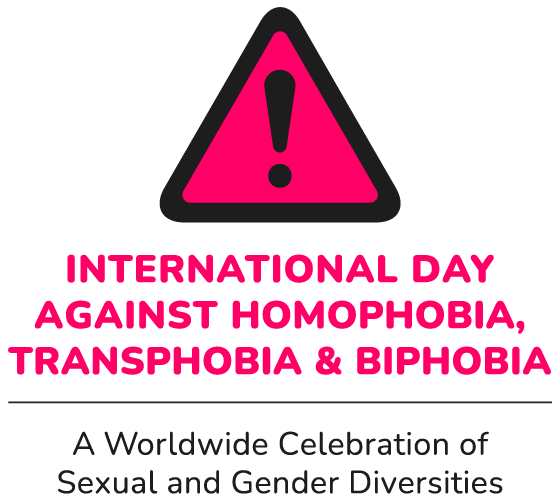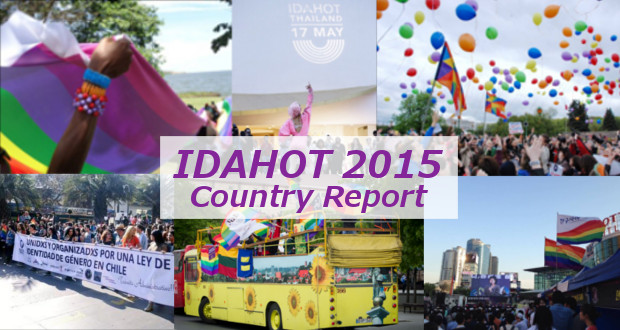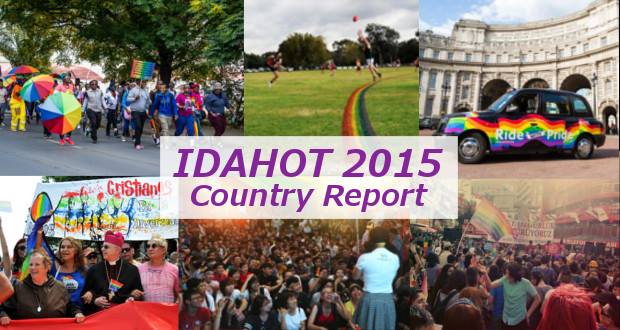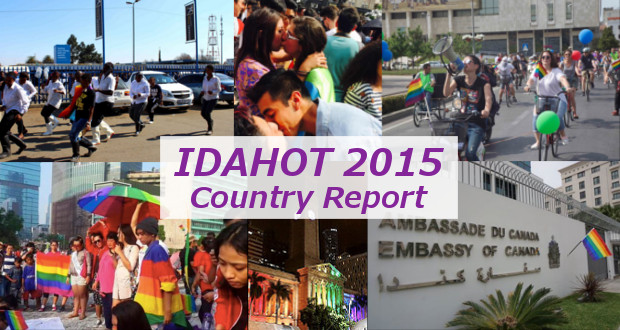In the United States of America widespread support was seen across the country. Actions were reported in at least 30 states, as well as in the halls of government, and many Americans from all backgrounds this year helped to make the International Day Against Homophobia, Transphobia and Biphobia one of the most successful yet.
Despite the day cooinciding with graduation season for many students, young people were especially involved in the day, helping to run and plan events, as well as supporting their local community in many different ways.
 In Washington D.C. President Barack Obama once again used the day to officially reaffirm his commitment to the equality of the LGBT community. Similar statements of support were also made by State Secretary John Kerry, First Lady Michelle Obama, Vice President Joe Biden, National Security Advisor Susan E Rice and Democratic Leader Nancy Pelosi.
In Washington D.C. President Barack Obama once again used the day to officially reaffirm his commitment to the equality of the LGBT community. Similar statements of support were also made by State Secretary John Kerry, First Lady Michelle Obama, Vice President Joe Biden, National Security Advisor Susan E Rice and Democratic Leader Nancy Pelosi.
In Congress over 60 members cosigned the ‘Congressional resolution in support of the goals and ideals of the International Day Against Homophobia and Transphobia’ which was introduced by Congresswomen Barbara Lee.
The resolution outlined the specific effects of anti-LGBT violence, homelessness and healthy issues seen within LGBT communities and acknowledged government’s role in alleviating these issues. Speaking during her announcement on the subject Congresswomen Lee stated “No young person should feel unsafe in their school, community or home because of their gender identity”.
Members of the country’s diplomatic authorities also helped to promote the day on an international level. Several American embassies across the world, including those in Laos, Madagascar, India, Armenia and many more, marked the day in several ways.
In many European countries staff members simply marked the day with an official statement, or symbolic action. In Madrid the openly gay Ambassador to Andorra and Spain, James Costos, proudly raised the rainbow flag above his embassy. In Oslo, Berlin, Stockholm, Vienna and several other cities the day was marked in a similar manner.
In Armenia US ambassador Richard Mills took further action to support the day by meeting with local equality campaigners to discuss support of their work. Activists were also supported in India, Jamaica and Argentina, as well as several other countries, and US embassy staff attended several official actions marking the day.
An overview of the support to IDAHOT actions by US missions is provided by Glifaa (the organisation of LGBT civil servants in US entities with foreign affairs components) HERE
The day was also supported by USAID (the United States Agency for International Development), who promoted the day online through various social media outlets. By sharing online resources, articles and messages of support the agency helped to raise awareness of the day among an audience mostly within developing countries where LGBT issues are sometimes rarely addressed.
Links related to IDAHOT were shared on the day through the USAID official Twitter and Facebook accounts, as well as by several other accounts run by smaller branches of the agency. The department’s website also published a number of articles around the day highlighting the work being done by campaigners, charity workers and activists around the world to improve the situation for international LGBT groups.
USAID’s Senior LGBT Coordinator, Todd Larson, was also featured in the Huffington Post in which he wrote about the work being done to empower LGBTI citizens throughout the world.
 In New York the United Nations’ Free & Equal campaign launched their campaign for IDAHOT 2015 with a special video promoting the day. The video, which featured individuals from the LGBTI community as well as a special appearance from UN General Secretary Ban Ki Moon, aimed to raise awareness and combat prejudice and stereotypes surrounding the LGBTI community by depicting individuals from a wide range of backgrounds in the diverse roles they hold within society. The video was released in the week leading up to IDAHOT online, and also premiered at New York’s Times Square, where it was broadcast for an entire day on one of the square’s giant outdoor screens.
In New York the United Nations’ Free & Equal campaign launched their campaign for IDAHOT 2015 with a special video promoting the day. The video, which featured individuals from the LGBTI community as well as a special appearance from UN General Secretary Ban Ki Moon, aimed to raise awareness and combat prejudice and stereotypes surrounding the LGBTI community by depicting individuals from a wide range of backgrounds in the diverse roles they hold within society. The video was released in the week leading up to IDAHOT online, and also premiered at New York’s Times Square, where it was broadcast for an entire day on one of the square’s giant outdoor screens.
American-based human rights campaign group and monitor, Human Rights Watch, marked the day with the release of a special app highlighting the current legal situations faced by LGBTI individuals across the world. The app uses data complied by the group to provide an up-to-date overview of the global LGBTI situation, as well as an extensive list of challenges faced by groups in their individuals countries.
The app also provides further information on the legal methods employed by countries to persecute LGBTI individuals, as well the punishments faced and the regions in which the situation is most severe.
Anti-bullying project It Gets Better marked the day by mobilising partners across the world to support the international LGBT community. Alongside local partner organisations IGB mobilised their global affiliates to organise in Portugal, Mexico, Italy, Chile, Moldova, Brazil and Australia.
Back in The States, the group worked with artist and campaigner Daniel Arzola to create a series of artworks depicting the many backgrounds and identities seen with the LGBT community. The series was released online with the aim of fostering diversity within America’s LGBTI groups. IGB also helped promote the day online by encouraging supporters to learn more about the project, and to engage themselves with local actions.
The American Psychological Association this year called upon American schools to become places of safety for young people as part of their commitment to IDAHOT. The group offered policy and program advice, as well as information about training and practices to help educational professionals improve their local situation for LGBTI youth. As well as promoting the day on a national level the group also released a special guide for university students and graduates on how to best engage with the day from a psychological background.
The Human Rights Campaign (HRC) marked the day with a special event in partnership with the UN Foundation and the United Nations Free & Equal Campaign. The event was held in Washington DC and attended by the HRC’s Global Director Ty Cobb, as well as the State Department’s Special Envoy for LGBT Rights, Randy Berry, and several UN members. During the event Berry drew attention to the important work being done by both state and independent groups towards the promotion of LGBT rights, and also praised several aspects being seen from the US.
The HRC also released a special video made for the day in which their team of special Youth Ambassadors shared their experiences working with the group and the broader LGBTI community. The ambassadors, made up of LGBT and ally youth from a broad range of backgrounds, were brought together by the HRC to advocate for and highlight the importance of LGBT issues facing young people across the world.
Also in Washington, advocacy group Human Rights First commemorated the day by hosting a Congressional briefing and reception highlighting the work of leading activists in the Caribbean. As part of the event Jamaican human rights defender Angeline Jackson, who was recently recognised for her work by President Obama during an official trip to Kingston, was invited to speak about her work with the LGBT community.
The Council for Global Equality also hosted an event for IDAHOT at the Art Museum of the Americas at the OAS on May 20. The event featured a speech and introduction by Senator Markey of Massachusetts and the events keynote was delivered by Randy Berry, Special Envoy for the Human Rights of LGBTI Persons. The 130+ guests included government officials from the US Gov., Embassy officials from Argentina-Netherlands-Serbia-
Campaign group NOH8 marked the day by releasing a special version of one of their iconic images. The image, depicting activists from the LGBT community ‘silenced’ with tape, was shared alongside a message of support with the LGBTI community in order to raise awareness and engagement for the day. The group also encouraged their supporters to engage with local events, and the day as a whole.
Health and education advocates Planned Parenthood highlighted the day with an article on their website, which discussed the work being done to promote health issues within the LGBTI community.
The Arcus Foundation also marked the day with online messages of support. The group also helped to promote the day through promotion on social media, as well as further support of their partner groups and individual activists.
LGBT leadership advocates and advising firm Out Leadership released a small series of images online to mark the day. These images featured quotes and images of LGBT global leaders from various backgrounds that helped to promote the idea of equality across all walks of life, including business and industry.
Also in the realm of business was the action taken by communications company Orange, who distributed posters in support of LGBT employees across 700 sites in America and parts of Europe.
Across the country the day, and events organised for it, were covered by a wide range of press outlets. Many events on a local level received coverage from local news outlets, while the day as a whole was covered by several larger publications, including the Huffington Post and the Advocate, both of whom published op-ed pieces highlighting the importance of May 17th within the LGBT community. The day was also covered on television and radio across the country.
In Washington State local government helped support the day after the Metropolitan King County Council officially proclaimed May 17th as the International Day Against Homophobia, Biphobia and Transphobia in a motion backed by local origanisations POW!, the Safe School Coalition and Supporting LGBTQ Youth.
In Atlanta, the Young Democrats of Georgia held a special ‘cookout-potluck’ in celebration of the day. The event took part in Atlanta’s Piedmont park and saw local activists invite the community for a day of food and celebration of the LGBTI community.
In Las Vegas local campaigners organised a special brunch to celebrate sexual and gender diversity. The event, attended by over 100 people, featured live music, free HIV testing and a special drag performance. A portion of funds raised was also donated to local LGBT charities.
In Palm Springs, California, campaigners from the Trans Community Project organised a candlelit vigil to remember the victims of transphobic violence lost in 2014 and 2015. The vigil promoted the message ‘#TransLivesMatter’. As part of the vigil supports remembered the lives of at least 35 known individuals who had died as a result of violence, neglect or suicide in their local community.
Organisers also used the event to raise awareness for the ongoing situation faced by many trans* individuals, in which they called upon an end to violence as well as increased support for the victims of transphobia. The event was also streamed live online and was covered by several local news outlets.
While many more small events took part across the country we are unable to list them all here. Of the many actions confirmed by activists and organisers this is no doubt just a small selection. From all backgrounds and all ages, it has been incredible to see people come together across the country to advocate on the issues facing their local communities. This year IDAHOT has been an incredible success for so many people and once again Americans have proven themselves to be some of the most engages in both local and international issues.




